Elder Cook Says Studying Church History Will Deepen Faith during Face to Face Broadcast
Contributed By Sarah Jane Weaver, Church News editor
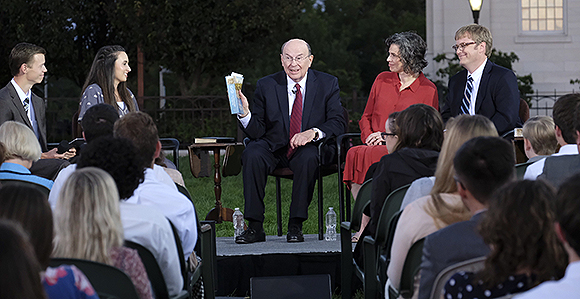
Elder Quentin L. Cook of the Quorum of the Twelve Apostles, center, addresses young adults ages 18 to 30 during a worldwide Face to Face broadcast focusing on the history of the Church. Also participating in the September 9, 2018, event were Church historians Kate Holbrook and Matt Grow.
Article Highlights
- The Church is not hiding its history but is making it more accessible, available, and understandable.
- Church history can withstand scrutiny.
- Studying it will deepen your faith and desire to live the gospel more fully.
- Take your questions to the Lord in prayer and then listen.
“In learning more, … we will find examples of imperfect people who went forward with faith and allowed God to work through them to accomplish His work.” —Elder Quentin L. Cook of the Quorum of the Twelve Apostles
Related Links
NAUVOO, ILLINOIS
With the historic Nauvoo Illinois Temple as a backdrop, Elder Quentin L. Cook promised young adult members of The Church of Jesus Christ of Latter-day Saints that studying the history of the Church will deepen their faith and their desire to live the gospel more fully.
“In learning more, we will bind our hearts together with Saints of yesterday and today,” said Elder Cook of the Quorum of the Twelve Apostles. “We will find examples of imperfect people who went forward with faith and allowed God to work through them to accomplish His work.”
Addressing young adults ages 18 to 30 in a worldwide Face to Face event, Elder Cook answered significant questions about Church history on Sunday evening, September 9.
Joined by Church historians Kate Holbrook and Matt Grow in the broadcast, Elder Cook spoke about polygamy, the methods Joseph Smith used to translate the Book of Mormon, the differing accounts of Joseph Smith’s First Vision, and other issues of historical importance. The Church is not hiding aspects of its 188-year-old history, he promised some 250 young adults on the temple grounds and some 400,000 more gathered in locations across the globe.
“Church history can be a significant source of faith,” Elder Cook said. But for some, Church history “has been misunderstood or overlooked” or “crowded out by larger concerns of the world.”
Some people “have even purposely misrepresented stories of the past to sow doubt,” he said.
Broadcast as the sun set along the banks of the Mississippi River, the Face to Face event was held to “inform and answer questions with an emphasis on Church history.” The broadcast followed the recent release of the Church’s new narrative history, Saints: The Story of the Church of Jesus Christ in the Latter Days. (See related story.)
Church leaders chose the location for the broadcast—just over the hill from the final resting place of Joseph Smith, his wife Emma, and his brother Hyrum—“because Nauvoo and this temple were so pivotal to the history of the Church,” said Elder Cook. “The temple meant everything to the early Saints, and the ordinances they received there empowered them to do remarkable things in building the kingdom of God.”
Elder Cook praised the generation—which has produced 600,000 full-time missionaries. “That is over 40 percent of all the missionaries that have ever served in this dispensation,” said Elder Cook.
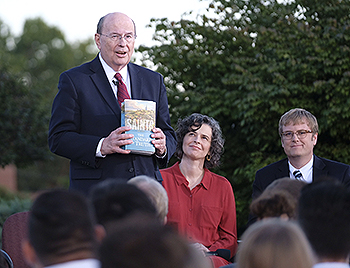
Elder Quentin L. Cook of the Quorum of the Twelve Apostles addresses young adults during a worldwide Face to Face broadcast focusing on the history of the Church. Also participating in the September 9, 2018, event in Nauvoo, Illinois, were Church historians Kate Holbrook and Matt Grow.
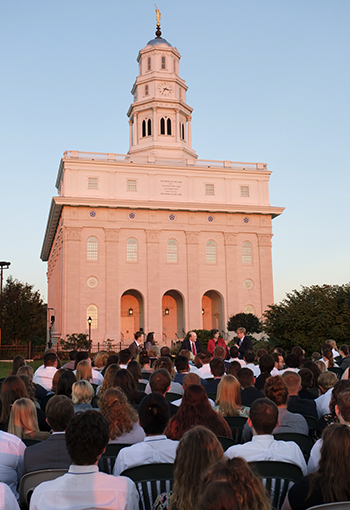
Young adults listen to Elder Quentin L. Cook of the Quorum of the Twelve Apostles speak during a worldwide Face to Face broadcast focusing on the history of the Church. Also participating in the September 9, 2018, event were Church historians Kate Holbrook and Matt Grow.
In preparation for the event, the Church received thousands of questions from young adults across the globe. Hosts Spencer Heslop, 24, and Maile Mayer, 18, read several questions during the broadcast, which focused on the time period from the First Vision in 1820 until the Saints completed the Nauvoo Temple in 1846. “We will answer as many as we can to give our perspective on the history of the Church,” said Elder Cook.
Grow said the early Church moved forward with young, faithful leaders and members. “The early Latter-day Saints moment was a movement of the young people,” he said. “That is one of the exciting things about speaking to the young adults of the Church; it was their age group who converted to the Church in the 1830s and the 1840s. It was their age group who built the Church.”
Holbrook said that “standing here in Nauvoo” has given her an awareness of how early Latter-day Saints “were able to prioritize faith in God’s will over every other consideration.”
“I have found that when I study Church history I gain spiritual ancestors,” she said. “Their examples, their experiences, their suffering—all of it is really meaningful to me. It makes me feel rooted. It makes me feel stronger than I did before learning their stories.”
Following are summaries of some of the topics addressed during the Sunday, September 9, broadcast from the grounds of the Nauvoo Illinois Temple.
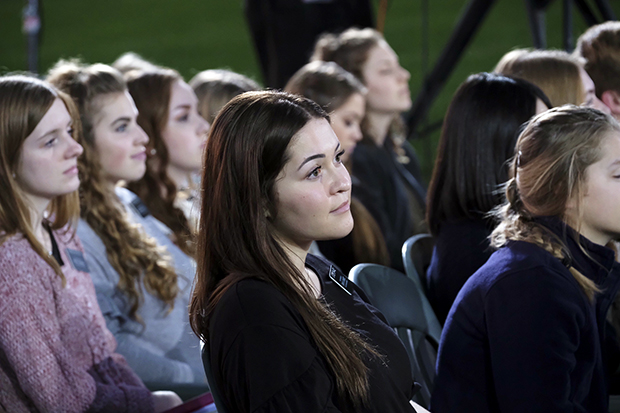
Young adults listen to Elder Quentin L. Cook of the Quorum of the Twelve Apostles as he addresses a worldwide Face to Face broadcast focusing on the history of the Church. The September 9, 2018, event originated in Nauvoo, Illinois.
The Church and transparency
Responding to the first question of whether or not the Church has been hiding information, Elder Cook, Holbrook, and Grow each assured the young adults of the Church’s commitment to history.
Elder Cook said there has always been a balance to teaching things that are essential, things that will lead to exaltation, and answering questions that are of concern to some in the Church.
Elder Cook said in the over 22 years he has been a General Authority, the desire of Church leaders “is to be as transparent as possible in terms of Church history and doctrine.”
Holbrook shared her own experiences with the hard topics of Church history, including plural marriage and seer stones. She learned of Brigham Young’s plural wives when she was just 4 years old when her mother and grandmother worked as volunteer tour guides at the Beehive House on Temple Square. Later, she learned that Joseph Smith had practiced polygamy. However, she didn’t learn about seer stones until she was an adult and gained an interest in Church history, even though the Church had published an article in the Friend magazine on the topic when she was 2 years old.
“The Church did not hide information from me, but the historical information was not emphasized to me,” she said. In Sunday School and seminary she learned “the main work of the Church”—to repent, to bring her life in harmony with the gospel of Jesus Christ, and how to establish a relationship with God. “These are the things in my life that I hold most dear.”
She acknowledged that it is painful for a person to learn of an aspect of Church history they thought they should have known but did not.
That is why Church historians “do the work that we do,” she said.
Grow said Holbrook’s story demonstrates the dynamic nature of the Church, where information has been available but has not been emphasized “sometimes because it feels uncomfortable and sometimes because the main purpose of Church meetings is to preach of the gospel of salvation.”
In addition, on many topics, Church leaders and historians know more now than they did 30 or 40 years ago, he said. “We do live in a new reality of the information age, when challenging information on Church history can appear on the social media feeds of members all around the world. So we have a heightened responsibility now to help members find good answers to their questions within the household of faith.”
Historical compilations such as the recently released Saints: The History of the Church of Jesus Christ in the Latter Days, the Joseph Smith Papers, and the Gospel Topics essays directly confront many of these challenging doctrinal and historical questions, he said. “The message to me of this openness is that the history of the Church can withstand scrutiny,” said Grow. “We don’t need to be afraid of it. It is inspiring. Sometimes we will have questions. But there are good answers.”
The Church History Department is not trying to hide or censor history but instead trying to make Church history “accessible, available, and understandable,” said Grow.
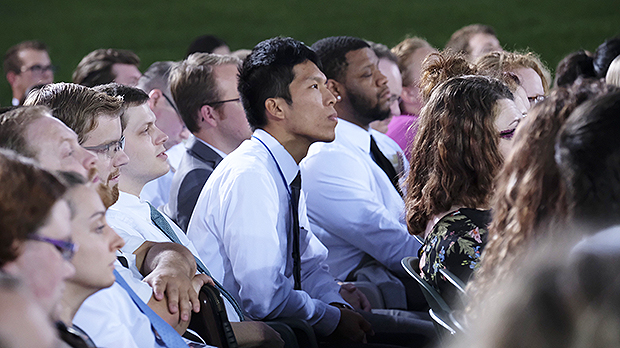
Young adults listen to Elder Quentin L. Cook of the Quorum of the Twelve Apostles as he addresses a worldwide Face to Face broadcast focusing on the history of the Church. The September 9, 2018, event originated in Nauvoo, Illinois.
A global history of the Church
Elder Cook spoke of Joseph Smith, who in 1834 in a 14-foot by 14-foot school room addressed all the priesthood leaders in Kirtland. He said they did not have a sense of the destiny of the Church. The Church would fill North America and South America and the entire world, Joseph Smith prophesied. “We are seeing that,” Elder Cook said.
Missionaries went out almost immediately, said Elder Cook. They went to Canada, Great Britain, the Middle East, and the Pacific. While serving as President of the Church’s Pacific Islands Area from 1998 to 2001, Elder Cook met a seventh-generation Latter-day Saint.
“Wherever you are in this world, whatever lineage you come from, you are important, you are part of Church history. We very much need you and want you, and you will bless people’s lives.”
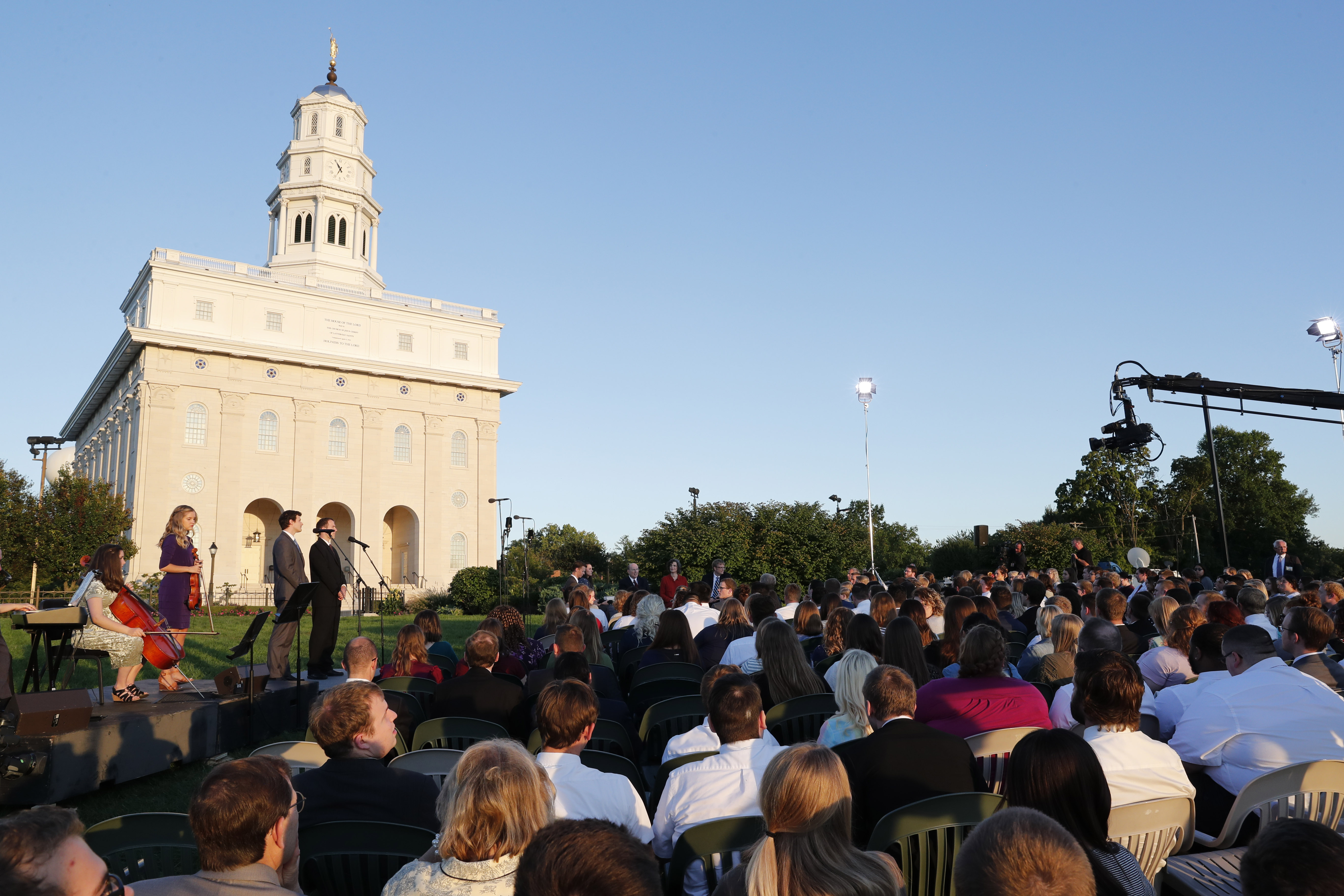
Musicians perform before Elder Quentin L. Cook of the Quorum of the Twelve Apostles addresses young adults during a worldwide Face to Face broadcast on September 9, 2018, that focused on the history of the Church. Also participating were Church historians Kate Holbrook and Matt Grow.
Reliable answers to questions of Church history
Grow said the challenge in the information age is not to find answers but rather to discern between good and bad information. “That is one of the central tasks of a historian.”
There are so many historical discussions online about the Church’s history, he said. “Most of these discussions produce a lot more heat than light. … Be careful about sources of information that just seek to tear people down. Look instead for sources of information that are based on the records left by the people themselves and that seek to be fair to them.”
It is easy to play “gotcha” with the past, to pull a quotation or incident out of context and make it look alarming, he said.
Church historians feel a great responsibility to write history that is honest and accurate.
Along with Saints, the Church published 100 essays called Church History Topics. They provide further information on various people, places, and events, he said.
Another area of interest is women’s history, said Grow. “Latter-day Saint women’s history is not just for women. It is for all Latter-day Saints. We are stronger as a people, stronger as a culture, when we hear the voices and learn from the experiences of women in the past.”
Church historians are also committed to telling the stories of the global Church, he said.
Elder Cook said there are many areas of knowledge where the internet is helpful. But in some areas—including politics and religion—there is “misinformation” and an “effort to distort things.”
He encouraged the congregation to seek credible sources, including Saints.
“It reads like a novel, but don’t be fooled by that,” said Elder Cook. “Everything in it is backed up by facts. If it says it was raining, it was raining. If it says that Parley Pratt was angry with the Prophet Joseph, he was.”
The book includes 71 pages of endnotes that will take the reader to other sources, said Elder Cook. “This is a book that you can use to answer questions. But if you read it, you are going to find that it builds your faith and helps you understand our ancestors and what they accomplished.”
Polygamy in the early days of the Church
Holbrook said she descends from people who chose to practice plural marriage—one was a seventh wife, one was a first wife. “Their example has taught me to center my life on faith,” she said. “Their example has taught me to keep putting one foot in front of the other and do so prayerfully.”
The instruction Church members have in the Book of Mormon about plural marriage is found in Jacob 2. Monogamy is God’s standard for marriage, and plural marriage is an exception that occurs only when God commands it. Holbrook said Joseph Smith was reluctant to practice plural marriage, but he eventually instituted it because he wanted to obey God’s commandment to him. He began to introduce the practice to others in 1841. “They were shocked,” Holbrook said.
As plural marriage was practiced officially for about 50 years “it was always something people could choose,” she said.
While scholars do not know the exact number of those who practiced plural marriage, those who did were in the minority, she said.
In 1890, the prophet Wilford Woodruff issued a manifesto that led to the end of plural marriage. “When some people heard this manifesto, they were relieved. It had been hard for them and they rejoiced,” Holbrook said. “And when some people heard this manifesto, they were devastated and they cried. They had sacrificed so much and they had testimonies of this principle.”
Grow said it is important to remember “the vast majority of Latter-day Saints throughout time have lived in monogamous marriages and monogamous families.”
An important aspect of Joseph Smith’s practice of plural marriage was a distinction made between sealings for time and eternity, which involved commitments in this life, and sealings for eternity alone, which only involved commitments in the life to come, Grow said. “We know that some of Joseph Smith’s sealings that appear unusual to us and are difficult to understand fall into the category of sealings for eternity alone and seem to be about creating links between families in the next life,” he said.
Grow said one purpose of polygamy was to raise up “seed or a righteous posterity.” The extensive family history records of the Church reveal that “20 percent of living Church members descend from those who practiced plural marriage,” he said. “We know that throughout time those families have been a strength to the Church.”
Elder Cook said it is clear there was a lot of sacrifice—as well as love and unity—in plural marriages, and they taught their children to sacrifice. Those children took the gospel of Jesus Christ across the world through missionary work, he said.
“In the senior councils of the Church, there is a feeling that polygamy, as it was practiced, served its purpose and we should honor those Saints, but that purpose has been accomplished.”
There are still unanswered questions, Elder Cook said. He testified that “we have a loving Heavenly Father who has a perfect plan, that His plan is one of happiness, that we have a Savior who did everything for us. We can trust in Them.” (Learn more.)
Differing versions of Joseph Smith’s First Vision
Grow said Joseph Smith wrote or asked scribes to write four different accounts of the First Vision. “The accounts tell a basically consistent story,” he said.
As a historian, he said, he would worry about “complete uniformity among the accounts” because “that is not the way that memory works.”
Grow compared the differing versions of Joseph Smith’s First Vision to a story one might tell of meeting his or her spouse when sharing that experience on four different occasions throughout a lifetime. A person might emphasize different details of the account in a journal entry the day it took place than when he or she does in a wedding video, in a letter written to a 12-year-old daughter, or in a recount told at a 50th wedding anniversary party. So it is with the First Vision accounts, he said.
Grow said it is hard to capture a sacred experience in language. “Joseph Smith himself called language a ‘narrow little prison.’”
Rather than be troubled by multiple accounts of the First Vision, Grow said Latter-day Saints should celebrate them.
Elder Cook testified that “Joseph did see God the Father and Jesus Christ, and he was the instrument for the Restoration of the gospel.” (Learn more.)
Translation of the Book of Mormon
In answering questions about the translation of the Book of Mormon, Holbrook held a copy of a first-edition book. “Kate, do you know how valuable a first-edition Book of Mormon is?” quipped Elder Cook.
Holbrook said Joseph Smith translated the Book of Mormon by the gift and power of God. “Some of us want a little more information than that, but that is what he told us. His translation experiences were sacred and very personal, and he just didn’t give us much detail,” she said.
Fortunately, he had scribes and friends who did share some of the translation process, she said. What is known is that he started with a scholarly approach—which did not work—and then turned to a revelatory approach, she added.
With the revelatory approach he used both the Urim and Thummim, which was buried with the plates, and a seer stone—something Joseph found on his own.
She said historians do know dictated pages of the Book of Mormon look fluid and clean, where a page from Joseph’s personal journal is full of crossed-out words and incomplete sentences. Holbrook said Emma Smith said Joseph would sit down and begin translation without asking for a reminder about where he had left off.
“It took three months to translate the Book of Mormon,” she said. “It took eight months to print it. It took six years to write Saints, volume one, although that involved a really long approval process.”
“What matters to me is the content of the Book of Mormon,” she said, adding, “The Book of Mormon has shaped who I am and how I see the world.”
Elder Cook shared his testimony of the Book of Mormon as the word of God and of the mission of the Prophet Joseph Smith. (Learn more.)
Times of persecution
Speaking of persecution, Holbrook spoke of Emma Smith leaving Missouri across the Mississippi River when it was “a little bit frozen.” A wagon could not travel across the wide river. Emma with her children—an infant in her arms and the other three ages 2, 6, and 8—walked across the river with the transcripts of Joseph Smith’s translation of the Bible under her skirt. With courage and faith, “she had to go out on the frozen river with the document and her children and take one step after another,” Holbrook said.
Elder Cook said he pondered early persecution of Church members as he was preparing spiritually for the Face to Face event. Before arriving in Nauvoo, Elder Cook and his wife, Sister Mary Cook, visited Far West and Liberty Jail and followed the route of the early Saints when they left Missouri. From Liberty Jail, Joseph received the “some of the most beautiful scripture,” found in Doctrine and Covenants 121, 122, and 123, said Elder Cook.
“Many of you have trials and tribulations; many of you have difficulties,” said Elder Cook, speaking of a loving Father in Heaven and Savior Jesus Christ.
While Joseph was in Liberty Jail, he received some bad news from Heber C. Kimball, that the justices of the Missouri Supreme Court had made the decision to not release him from jail, recalled Elder Cook.
He said Joseph told Heber to be of good cheer and then instructed him to “get all the Saints out.”
“There is a lesson for you in that. Be of good cheer regardless of what you are being challenged with. But if you have things that are tempting you, get away from those.”
The example of Joseph in Liberty Jail and the Saints leaving Missouri without him is a wonderful example of strength and faith in the Lord Jesus Christ, said Elder Cook.
Significance of the Restoration
When speaking of the Restoration, Holbrook spoke of applying the gift of the Holy Ghost.
She asked the young adults to take their questions to the Lord in prayer and then to listen.
“I am grateful for the Holy Ghost.”
Grow said the early Church was really a church of young adults.
When Joseph Smith died, the Nauvoo Temple was still uncompleted, he said. Some months later, it become apparent to Brigham Young that the Saints would be driven from Nauvoo. Brigham Young asked the Lord if they should go or stay and finish the temple. Brigham was instructed to stay. In December 1845 enough of the temple was completed that it could be partially dedicated. The Saints worked “around the clock to prepare everyone spiritually for the journey west.”
Speaking of the Restoration, Elder Cook expressed gratitude for the Book of Mormon. “First of all, just think of having the Book of Mormon. Just think of having another witness of Jesus Christ.”
Elder Cook has served as a General Authority under three Church Presidents—Presidents Gordon B. Hinckley, Thomas S. Monson, and Russell M. Nelson. He noticed that when each was sustained as prophet, their hearts turned “towards the ordinances of the temple in a very dramatic way.” They each had “a sense of how significant [the temple] is to those of us here on this earth.”
As an Apostle, Elder Cook closed by bearing witness of Jesus Christ. “I am a sure witness of His divinity. I want you to know that He guides and directs the gospel and the Church in a way that will bless all of us. I testify to you that He lives.”
